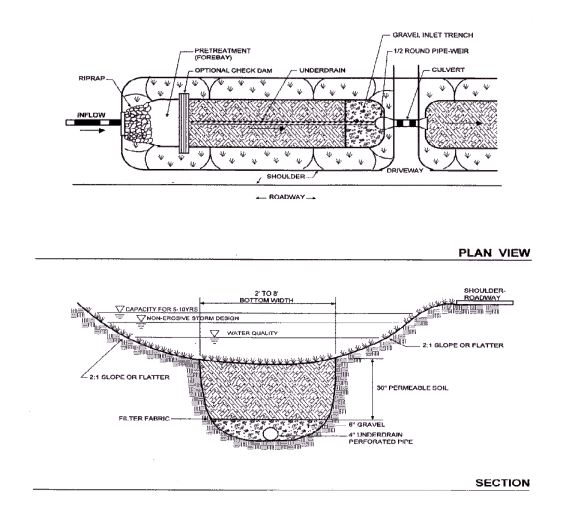
Stormwater Design Example: Dry Swale

DRY SWALE DESIGN EXAMPLE
This example describes in detail the design of a dry swale to treat stormwater runoff from the Brown Community Center (Figure 1). The swale must meet the following design criteria:
Design volumes and hydrology are provided in Tables 1 and 2.
Specific sizing criteria may vary between jurisdictions. For more information please consult the Sizing Options and Performance Criteria - Open Channels sections.
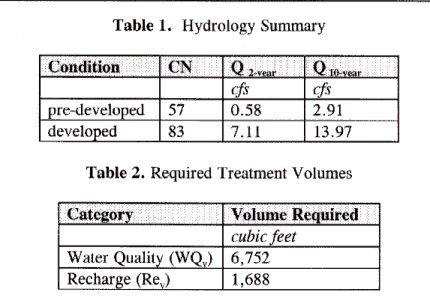
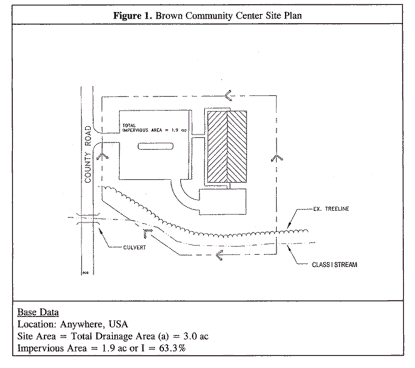
Site Specific Data:
Existing ground elevation at STP location is 22.0 feet, mean sea level. Soil boring observations reveal that the seasonally high water table is at 13.0 feet and underlying soils are silt loams (ML). Adjacent creek invert is at 12.0.
Step 1. Compute WQv
WQv previously determined to be 6,752 cubic feet. See Table 2.
Step 2. Compute REv
This dry swale design will have an "open bottom" (i.e., no impermeable liner (Figure 2)) to allow ground water recharge. 100% of the recharge volume (1,688 cubic feet) is contained within the WQv.
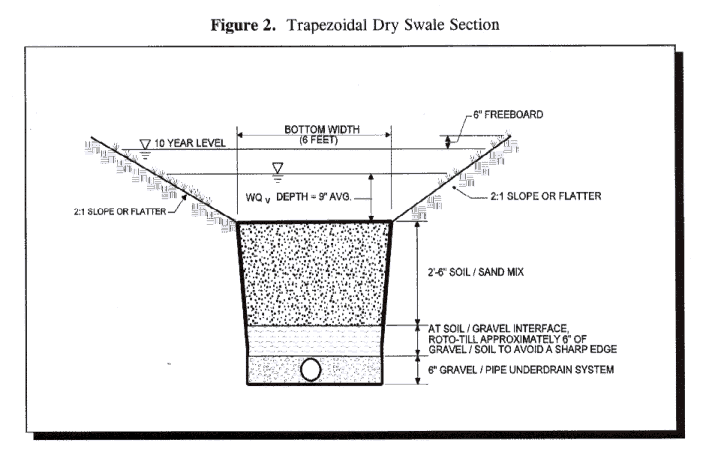
Step 3. Pretreatment:
Provide pretreatment in two shallow forebays at the head of the swales. As a target, provide 0.1"/impervious acre on the site. Divide this volume equally between the two forebays so that each provides 0.05"/ impervious acre of drainage.
(1.9 ac) (0.05) (1ft/12) (43560 sq ft/ac) = 344.9 cubic ft
![]() This
is a typical pretreatment requirement. See
the Performance Criteria - Open Channels section for more information.
This
is a typical pretreatment requirement. See
the Performance Criteria - Open Channels section for more information.
In addition, use a 2-0 pea gravel drain at the head of the swale.
![]() This
feature provides supplemental pretreatment.
This
feature provides supplemental pretreatment.
Step 4. Identify swale dimensions:
Provide bottom width, depth, length, and slope necessary to store WQv with less than 18 of ponding.
Assume a trapezoidal channel with a maximum WQv depth of 18. Control for this swale will be a shallow concrete wall with a low flow orifice trash rack (Figure 4). Per the site plan, we have about 1225 of swale available if the swale is put in with two tails (Figure 3). The outlet control will be set at the existing invert minus three feet (22.0 - 3.0 = 19.0). The existing uphill invert for the northwest fork is 24.0 (length of 400). The invert for the northeast fork is 28.0 (length of 825).
Slope of northwest fork is (24 - 19)/400 = 0.0125
or 1.25%
Slope of northeast fork is (28 - 19)/825
= 0.0109 or 1.10%
minimum slope is 1.0 % [okay]
![]() Minimum
slope criteria are specified in the Performance
Criteria - Open Channels
section.
Minimum
slope criteria are specified in the Performance
Criteria - Open Channels
section.
For a trapezoidal section with a bottom width of 6, a WQv average depth of 9, 2:1 side slopes, compute a cross sectional area of (6) (0.75) + (0.75) (1.5) = 5.63 ft2 (see Figure 2).
(5.63 sq ft) (1,225) = 6,897 cubic feet [ WQv of 6,752 ft�, OK]
Step 5. Compute number of check dams (or similar structure) required to detain WQv (see Figure 5)
For northwest fork, 400 ft @ 1.25% slope, and
max. depth at 18, place checkdams at: 1.5/0.0125 = 120'
Place at 120, 4 required
For northeast fork, 825 ft @ 1.10% slope,
and 18" depth, place checkdams at 1.5/.011 = 136.4
Place at 140, 6 required
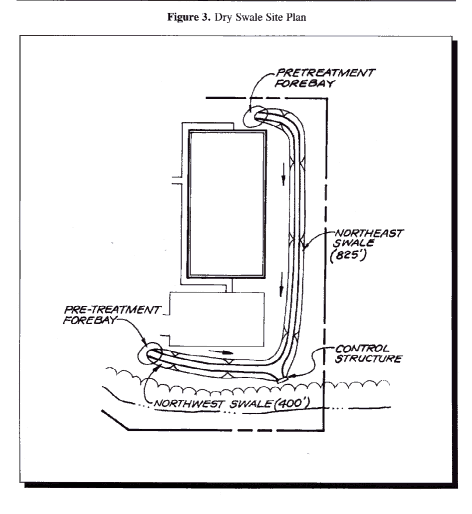
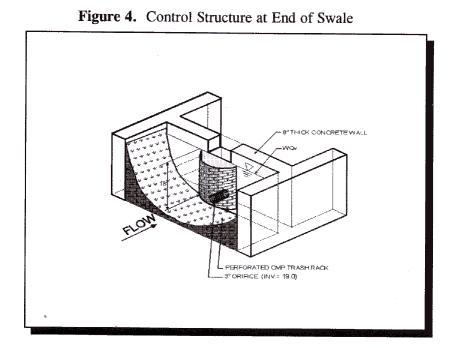
Step 6. Calculate draw-down time
In order to ensure that the swale will draw down within 24 hours, the planting soil will need to pass a max. rate of 1.5 in 24 hours (k = 1.5 per day). Provide 6 perforated underdrain pipe and gravel system below soil bed (see Figure 2).
![]() Limiting
drawdown time prevents risks of damp ground and potential mosquito infestation.
Limiting
drawdown time prevents risks of damp ground and potential mosquito infestation.
Step 7. Check 2-year velocity erosion potential:
From hydrology information, the two-year flow is 7.11 cfs. Assume that 30% goes through northwestern swale (2.13 cfs) and 70% goes through the northeastern swale (4.98 cfs). Design for the larger amount (5.0 cfs). From separate computer analysis using a Manning's n value of 0.03 for tall grass and a slope of 1.1%, the two-year velocity will be 2.4 feet per second at a depth of 0.35 feet. [provide at least 0.35 above top of check dams, two year v less than 5 fps, okay]
Step 8. Check 10-year velocity erosion potential and freeboard:
From hydrology information, the ten-year flow is 14.0 cfs. Assume that 30% goes through northwestern swale (4.2 cfs) and 70% goes through the northeastern swale (9.8 cfs). Design for the larger amount (9.8 cfs). From separate computer analysis, with a slope of 1.1%, the ten-year velocity will be 2.9 feet-per-second at a depth of .45 feet, provide an additional .5 of freeboard above top of checkdams or 1.0' (total channel depth = 2.5).
Find 10 year overflow weir length required: (weir eq. Q= CLH3/2), where C = 3.1, Q10 = 9.8 cfs, H =1.0; L = 9.8 cfs/ (3.1*1.01.5) = 3.2' Use 4 ft
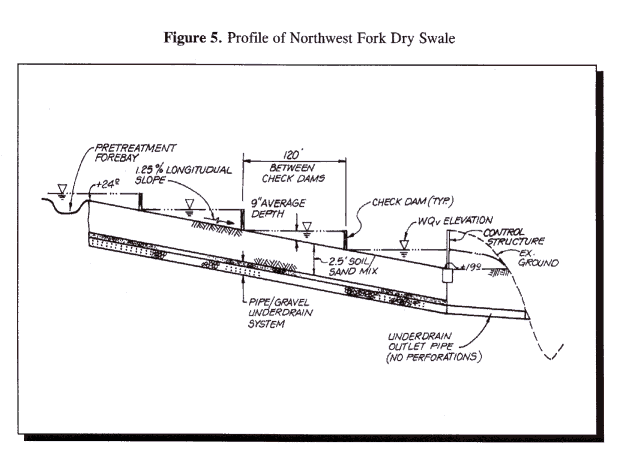
Step 9. Specify vegetation:
Use K-31 tall fescue in this case.
Step 10. Design low flow orifice at headwall (See Figure 4):
Design orifice to pass 6,897 cubic feet (calculated
in Step 4) in 6 hours.
6,897 cubic feet/ (6 hours) (3600 sec/hour)
= 0.319 cfs
use Orifice equation: Q = CA(2gh)�
assume h = 1.5
A = (0.319 cfs) / [(0.6) ((2) (32.2 ft/s2)
(1.5'))�]
A = 0.054 sq ft, dia = 0.206 feet or 2.47
use 3 minimum orifice size
Provide 3 v notch slot in each check dam